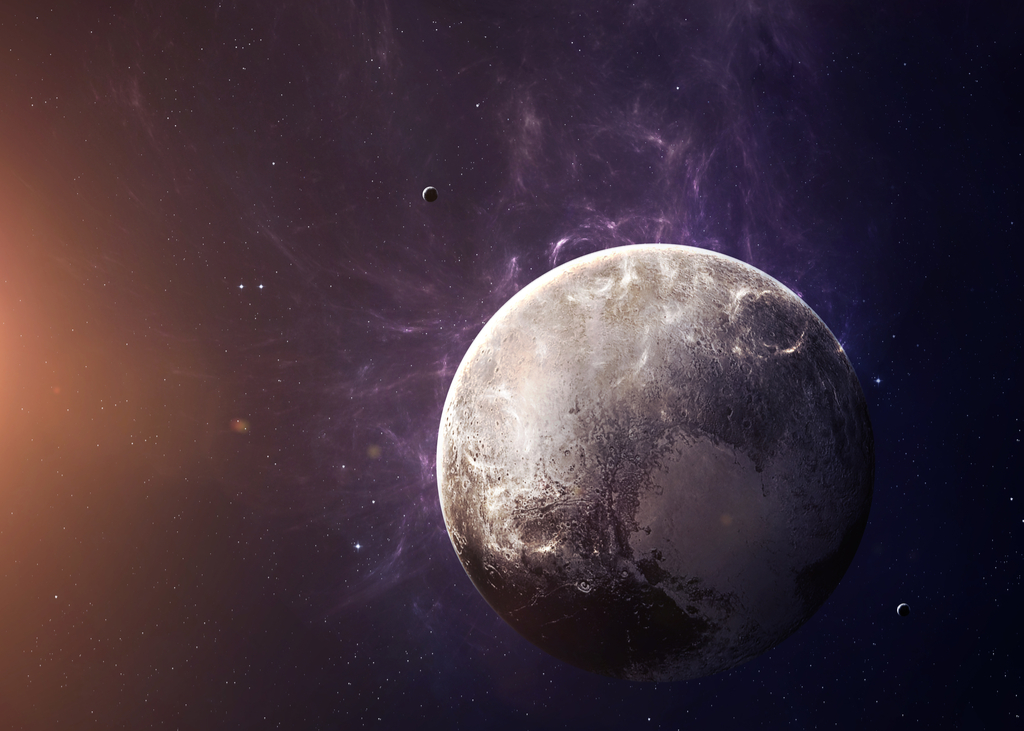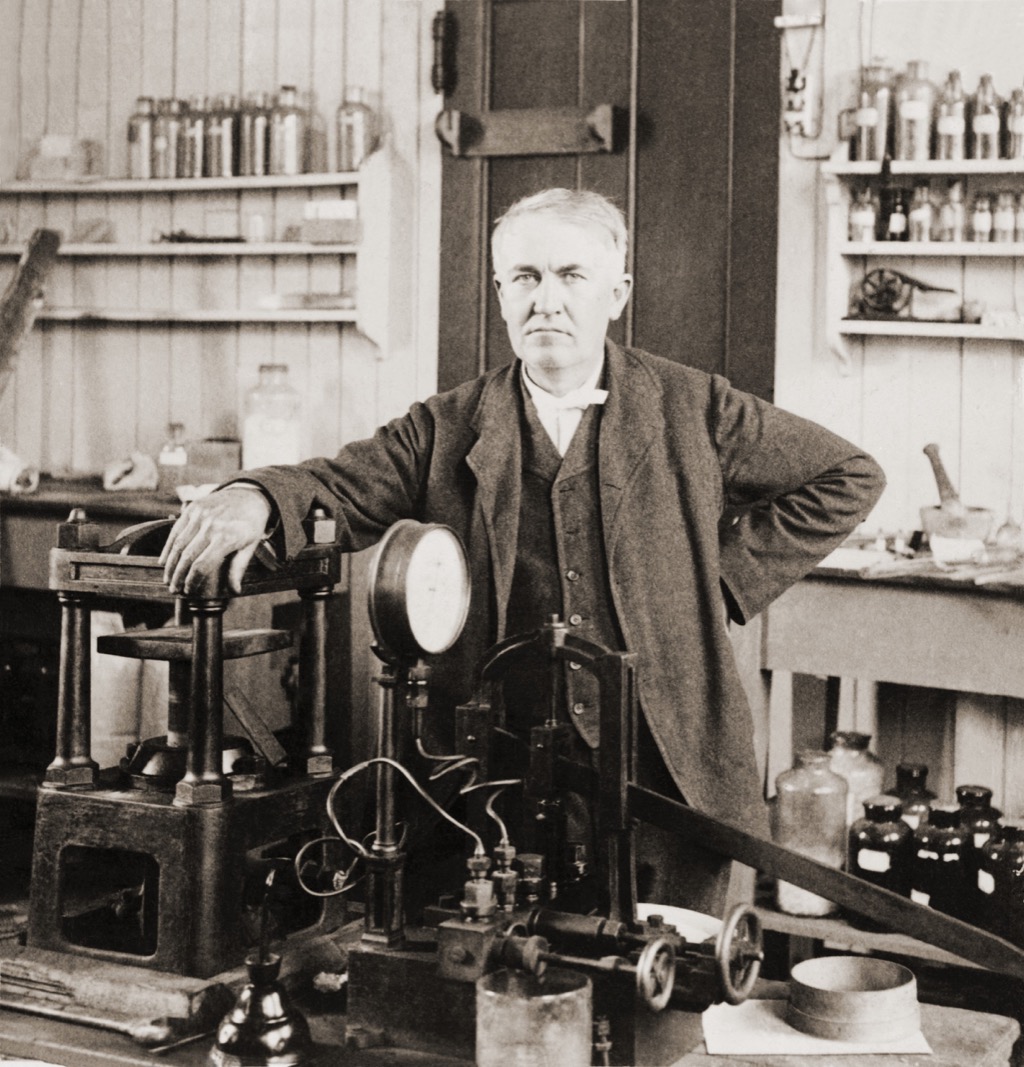25 Things We Learned in School That Were Completely Wrong
Don't believe everything you learn in school, kids!

While we're from the school of thought that education is important, the truth is that some of your teachers were likely—albeit unintentionally—spreading fake news. That's right: A lot of the "facts" you struggled to memorize as a kid were not facts at all, but false information entirely. From Christopher Columbus fallacies to myths about your blood, these following common school lessons are as untrue as the "my dog ate my homework" excuse.
1
False fact: Chameleons always blend in with their backgrounds.

Reality: Contrary to a widely held belief—one that is bolstered by kindergarten teachers giving inaccurate lessons on lizards—these reptiles don't transform every time they come upon a new color. In fact, they don't even have the ability to match every background they slither up to, according to National Geographic. Yes, chameleons can change the color of their skin to match certain environments, but their color options are limited. What's more, when they aren't trying to blend in, their skin color changes to reflect their mood.
2
False fact: Christopher Columbus discovered America in 1492.

Reality: By now you probably know that everything you were taught about Columbus is unreliable. For example, contrary to what you learned in school, the explorer did not discover America when he landed there in 1492; the land had previously been inhabited for centuries by Native Americans. Plus, many scholars believe that other explorers from Europe, Asia, and Africa had already landed in America long before Columbus.
3
False fact: Columbus discovered that the Earth wasn't flat.

Reality: Columbus didn't discover America. He also didn't discover that the Earth wasn't flat. In fact, it's likely that he already knew it was round when he set off to supposedly debunk the "flat Earth" theory.
Historians believe that educated people in Columbus's day—and even those centuries earlier—knew that the Earth was round, according to The Washington Post. Columbus apparently even owned a book called Geography that described planet Earth as being of a spherical shape. Columbus was not concerned with falling off the Earth's edge, but rather with the size of the ocean he wanted to cross.
4
False fact: The seasons are determined by the Earth's proximity to the sun.

Reality: Contrary to what you were taught about the Solar System, the seasons have nothing to do with the Earth's proximity to the sun. Rather, according to NASA, it's the Earth's tilt that causes fall, winter, spring, and summer.
5
False fact: Abraham Lincoln singlehandedly abolished slavery.

Reality: Though U.S. history teachers often credit Abraham Lincoln with the abolishment of slavery, it wasn't that straightforward. According to History.com, Lincoln wasn't even in favor of both races having equal rights, and he didn't even technically free all the slaves with his Emancipation Proclamation. The Virginia Museum of History & Culture points out that in recent decades "some historians have minimized Lincoln's role and argued that the enslaved freed themselves."
6
False fact: Listening to classical music can make you smarter.

Reality: Did you ever have a teacher who insisted that you listen to classical music during silent reading to boost your brainpower? Well, while this music might have enhanced your musical knowledge, there's no scientific evidence to back up the theory that it boosted your overall intelligence. Though Dr. Alfred A. Tomatis's "Mozart effect" theory claimed that listening to the composer would make you smarter, a later meta-analysis of 16 different studies proved that listening to music only leads to a temporary improvement in mental skills.
7
False fact: Pluto is a planet.

Reality: Your understanding of Pluto depends on in what year you learned about the solar system. However, either way, what you learned probably isn't true, seeing as simplifying Pluto down to either a planet or not a planet isn't accurate. According to NASA, it's currently categorized as a dwarf planet, which is like a planet except that it doesn't travel around the sun in a perfect circle.
8
False fact: Raindrops are all tear-shaped.

Reality: No, raindrops are not tear-shaped. Rather, NASA notes that they are shaped more like halves of hamburger buns, and they tend to morph as they fall toward Earth.
9
False fact: You can never start a sentence with a conjunction.

Reality: Sure, some professors might not like sentences that start with conjunctions, but when it comes to grammatical correctness, conjunctions are OK. "There is a widespread belief—one with no historical or grammatical foundation—that it is an error to begin a sentence with a conjunction such as and, but or so," the Chicago Manual of Style says. "In fact, a substantial percentage (often as many as 10 percent) of the sentences in first-rate writing begin with conjunctions. It has been so for centuries, and even the most conservative grammarians have followed this practice."
10
False fact: Your blood is blue when it's deoxygenated.

Reality: When learning about your body, you were probably told that deoxygenated blood is blue. However, that's untrue. Your blood is actually red, regardless of whether it's in contact with oxygen. According to Live Science, the blue hue of the veins inside your body has to do with how your eyes absorb and see color.
11
False fact: We only use 10 percent of our brains.

Reality: This myth has been reinforced over the years by popular movies like Lucy and Limitless. However, research shows that the brain uses about 20 percent of the body's energy. In an interview with Scientific American, Dr. Barry Gordon, a professor of neurology at Johns Hopkins School of Medicine, even noted that humans "use virtually every part of the brain."
12
False fact: Swallowed gum doesn't digest for seven years.

Reality: One of the many reasons teachers offered for making you spit out your gum was that if you swallowed it, it would stay in your body undigested for seven years. Unsurprisingly, though, that was simply a lie meant to scare you out of chewing gum during class. Most people empty their stomachs anywhere from 30 to 120 minutes after eating—and when this happens, any swallowed gum leaves the body almost as quickly as it entered, according to Duke Health.
13
False fact: Camels use their humps to store water.

Reality: Contrary to what you've been taught about thirsty camels in the desert, the animals don't use their humps to store water. Rather, according to The Library of Congress, their mounds are filled with fat so that they can travel days through the desert without food.
14
False fact: Eating carrots will help your vision.

Reality: Carrots are rich in beta carotene, a nutrient that the body converts to a form of vision-enhancing vitamin A called "retinal," University of California, Berkeley points out. However, this benefit doesn't apply to you unless you are deficient in vitamin A due to a poor diet, malabsorption problems, or alcoholism. Most Americans get enough beta carotene and vitamin A in their diets already, so don't worry about adding carrots to every meal just to maintain your 20/20 vision.
15
False fact: Benjamin Franklin discovered electricity when he was struck by lightning.

Reality: History teachers probably taught you that Benjamin Franklin discovered electricity while flying a kite in a rainstorm. However, there is a lot of debate among historians as to whether that actually happened, in part because the electric shock would have killed him. What's more, The Franklin Institute even notes that "Franklin wasn't the first to demonstrate the electrical nature of lightning." Basically, Franklin didn't get struck by lightning, nor was he the first to discover electricity—but he was one of the first people to observe it carefully and closely.
16
False fact: Thomas Edison invented the light bulb.

Reality: When it came time to learn about inventions, you were probably told that Thomas Edison invented the light bulb. However, there was at least some iteration of a light bulb in existence before Edison's. As Time notes, "his light bulb was the first that proved practical, and affordable, for home illumination."
17
False fact: Sir Isaac Newton discovered gravity when an apple fell on his head.

Reality: Teachers love to tell the fun anecdote of Sir Isaac Newton discovering gravity when an apple fell on his head to get kids interested in gravity. And while it has been confirmed that Newton was in an orchard when he witnessed an apple drop from a tree, there is no evidence to prove that it hit him on the head. Also, that's not how the scientist "discovered" gravity. It simply got him thinking about the concept and eventually led to his discovery of the law of universal gravitation.
18
False fact: There is no gravity in space.

Reality: According to NASA, a small amount of gravity can be found everywhere in space. The organization notes that "gravity is what holds the moon in orbit around Earth. Gravity causes Earth to orbit the sun." Mind. Blown. And for more realities that are almost too insane to believe, check out these 17 Crazy Historical Facts That Are Worth Repeating Over and Over.
19
False fact: The Great Wall of China is the only man-made object visible from space.

Reality: Teachers love to tout the fact that the Great Wall of China is the only man-made object visible from space. However, that's incorrect. The Great Wall of China usually isn't visible from space, at least not "to the unaided eye in low Earth orbit. It certainly isn't visible from the Moon," NASA clarifies.
20
False fact: Humans only have five senses.

Reality: Touch, sight, taste, smell, and hearing are just the five basic senses—and there's a good chance your teacher didn't go past those. Other senses include the sense of space, balance, pain, and temperature.
21
False fact: The tongue is divided into taste bud zones.

Reality: Remember that handy map you got in biology class that depicted the tongue with taste bud zones? Yeah, you can throw that out (if you still have it for some reason). The fact of the matter is, it's not actually true that you can only taste certain things on certain parts of your tongue. While some areas are more sensitive to certain flavors, the average human has up to 8,000 taste buds scattered all over their tongue, each of which contains a mixture of receptor cells that can process any and all of the five tastes.
22
False fact: Rosa Parks didn't give up her seat on that bus because she was tired.

Reality: Some people paint Rosa Parks to be a lot more passive than she was. In school, students are often taught that she didn't give her seat to a white person on the bus because she was too tired to move, but this wasn't the case. "People always say that I didn't give up my seat because I was tired," the civil rights leader wrote in her autobiography, "but that isn't true. I was not tired physically… No, the only tired I was, was tired of giving in."
23
False fact: You can always use the North Star to guide your way home because it's the brightest star in the sky.

Reality: While the North Star might help you find your way home, it's not because it's the brightest star in the sky. Rather, EarthSky notes that there are many stars that shine brighter than Polaris; it's only No. 50 on the list of brightest stars.
24
False fact: The original Thanksgiving was a peaceful gathering.

Reality: As schoolchildren, the days before Thanksgiving were spent making hand turkeys and talking about what we were thankful for. However, this idea that Thanksgiving was historically about peace and thankfulness is completely false. After colonial soldiers slaughtered 700 Pequot men, women, and children, Massachusetts colony governor John Winthrop decided to host a party to celebrate those soldiers. Suffice it to say that the first Thanksgiving was a far cry from peace and unity.
25
False fact: Most of your body heat escapes through your head.

Reality: Whether it was in science class or recess, it's likely you learned that hats were essential in winter because most of your body heat escapes through your head. However, it's time to toss this theory (and your hat) aside: Research shows that only a small amount of heat is lost through the head, and that larger surface areas like the arms and legs should be the main focus. "The body should be protected but…. it is a matter of individual preference whether or not to cover the head," one 2008 study in the British Medical Journal notes. And for more falsehoods debunked, don't miss The 40 Most Enduring Myths in American History.
To discover more amazing secrets about living your best life, click here to follow us on Instagram!





















